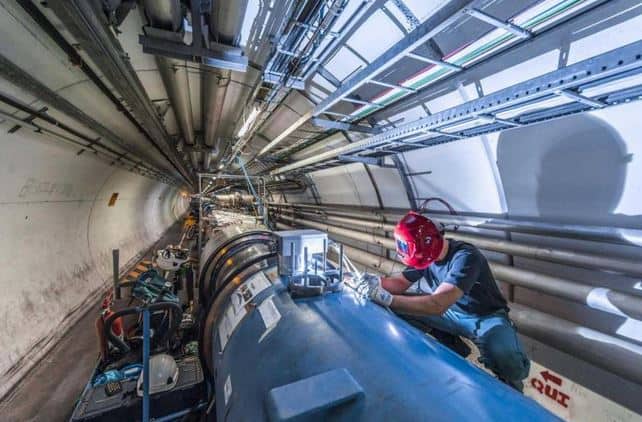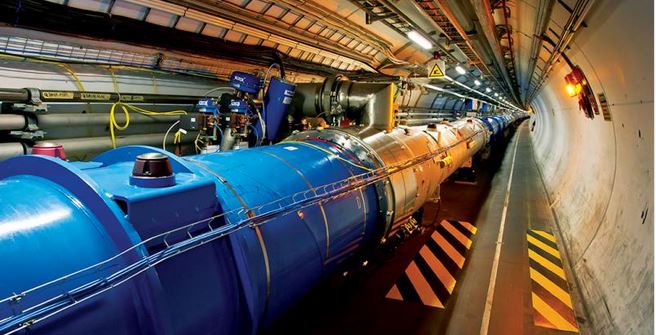A new particle that is even more exciting than the Higgs boson could be detected this year, a Large Hadron Collider scientist said at the annual meeting of the American Association for the Advancement of Science (AAAS) in San Jose, California.
The Large Hadron Collider (LHC) is the largest and most powerful particle collider in the world, and also the largest single machine on the planet. It was built by CERN (European Organization for Nuclear Research). It lies in a tunnel 17 miles (27 km) in circumference beneath the French-Swiss border near Geneva.
The LHC’s aim is to allow physicists to test the predictions of various theories of particle physics and high-energy physics, and particularly to prove/disprove the existence of the theorized Higg’s boson (proved in 2013).

A welder consolidating interconnections between dipole magnets on the Large Hadron Collider. (Image: CERN)
A more powerful accelerator
The accelerator is scheduled to come back online in March 2015, following an upgrade that will make it more powerful. The extra power could force the first supersymmetric particle to appear in the machine – most likely the gluino, which would give scientists a better understanding of what “dark matter” is.
It has been nearly two years since the beams in the LHC were switched off, marking the end of the accelerator’s first 3-year run.
According to CERN, hundreds of technicians and engineers have been repairing and strengthening the machine in preparation for the LHC at the higher energy.
When the LHC restarts, the energy of particle collisions will be 13 TeV (6.5 TeV per beam), versus 8 TeV in 2012.
Spokesperson for the Atlas experiment, one of the big particle detectors at the LHC, Prof. Beate Heinemann, said:
“It could be as early as this year. Summer may be a bit hard but late summer maybe, if we’re really lucky.”
“We hope that we’re just now at this threshold that we’re finding another world, like antimatter for instance. We found antimatter in the beginning of the last century. Maybe we’ll find now supersymmetric matter.”

The Large Hadron Collider – the world’s largest and most powerful particle accelerator. (Image: CERN)
What is supersymmetry?
Supersymmetry, an addition to the Standard Model, is a theory commonly found in some forms of string theory that suggests that when the Universe was created, the same number of theoretical “superparticles” were created.
If the supersymmetry theory is right, it would mean that there are at least twice as many particles in the Universe.
Since there are several dimension, possibly up to 11, supersymmetry may create more than just one copy. The supersymmetry theory solves several inconsistencies in the Standard Model of physics, hence many scientists believe it is true.
Supersymmetry, also known as “Susy”, fills some gaps in the model and would basically explain the unity of nature’s forces.
Suzy predicts that each particle has at least one massive partner, for example a photon would have a partner called a photino, a quark (building blocks of neutrons and protons) would have a squark.
Scientists were disappointed when LHC, before this latest upgrade, failed to show signs of these superparticles in the debris when it was colliding matter.
Now, theorists are hoping the more powerful accelerator will be able to provide the first evidence of Susy.
The upgraded LHC has double the energy. Theorists are convinced that the gluino really will show up in sufficient numbers to be detected. The gluino is the gluon’s superpartner. The gluon “glues” quarks together inside neutrons and protons.
The researchers will not be able to see the gluinos directly. They will track its decay, which should contain the lightest and most stable superparticles – the neutralinos. Scientists believe neutralinos are what make up dark matter.
Prof. Heinemann said “This would rock the world. For me, it’s more exciting than the Higgs.”
Video – the Large Hadron Collider
